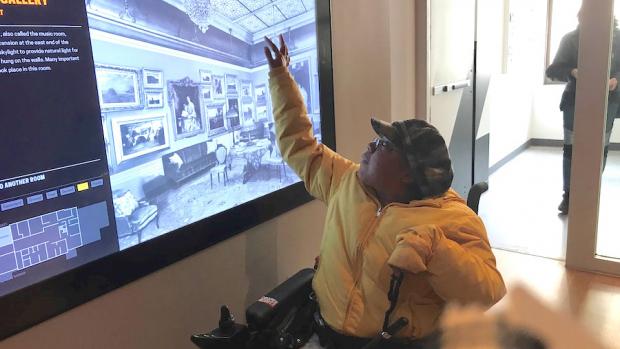Re-envisioning the Museum for Visitors of All Abilities
Students in NYU’s Ability Project Partner with Cooper-Hewitt to Design a Barrier-Free Museum Experience

When R. Luke DuBois, professor of Integrated Digital Media (IDM) at NYU Tandon and co-director of the NYU Ability Project, met Caroline Baumann, the director of the Cooper-Hewitt, an arm of the Smithsonian that showcases design and decorative arts, she shared with him her desire to make the museum more accessible to all visitors, including people with disabilities. The task was complicated, however, by the Cooper-Hewitt’s small staff and limited resources, as well as by its unique, historically landmarked location — the Andrew Carnegie Mansion directly off Central Park. The encounter sparked a fruitful partnership: the Ability Project, then marking its fifth year of combining technology with human-centered design to impact lives, would launch a new client-centered course, driven by NYU students and aimed at reimagining the museum as a more accessible and inclusive space.

The Ability Project prototypes for museum wayfinding for people with visual impairments.
Claire Kearney-Volpe, a research fellow at the Ability Project, and Dominick Propati, a Tandon adjunct professor, oversaw graduate students from IDM and NYU Tisch’s Interactive Telecommunications Program (ITP) who teamed up with museum staff and curators to develop solutions and prototypes for new signage and exhibits, accompanying audio and visual components, accessible navigation within the historic mansion, an improved website, and more diverse multimodal options for interacting with exhibits. From guest lectures with self-advocates and artists, to museum tours and feedback sessions with consultants, the partnership and the students’ approach revolved around inclusive design.
The Cooper-Hewitt Design Journal highlighted the course in its summer issue, noting the unique opportunity the partnership offered for students to envision the museum space as both a laboratory and incubator for design ideas.
“We set up the class so that students not only engaged with museum staff, but also with people who have a range of disabilities. We wanted them to learn from New Yorkers with lived experiences of the barriers that exist when accessibility is not a consideration in the design of museum websites, exhibitions, and interactives,” Kearney-Volpe said.
“Integrating accessibility can at times feel challenging, as you can’t just do it once. It’s an ongoing conversation that must be foregrounded and part of everything a company or institution does. That’s where the Ability Project can come in and help, because we have a lot of multidisciplinary expertise,” DuBois explained. “Tandon students can come up with technical applied solutions, through engineering and design, while students from other NYU schools can contribute their unique skills.”
— Professor R. Luke DuBois
DuBois hopes the partnership will continue, especially since the museum has hired some of those who completed the course and presented them with practical, real-world ideas. “I think the energy of the students really impressed the museum, and we’re looking forward to the next steps,” DuBois said. “There’s an idea that accessibility can be infectious. We can do a semester-long project with a major New York cultural institution, and they’ll catch the bug and want to continue with it in their own direction. We can impact not just the institution, but all of New York. There are very few universities that think about accessibility, design, and engineering the way we do.”
Camila Ryder
Graduate School of Arts and Science
Master of Arts in English Literature, Class of 2018




